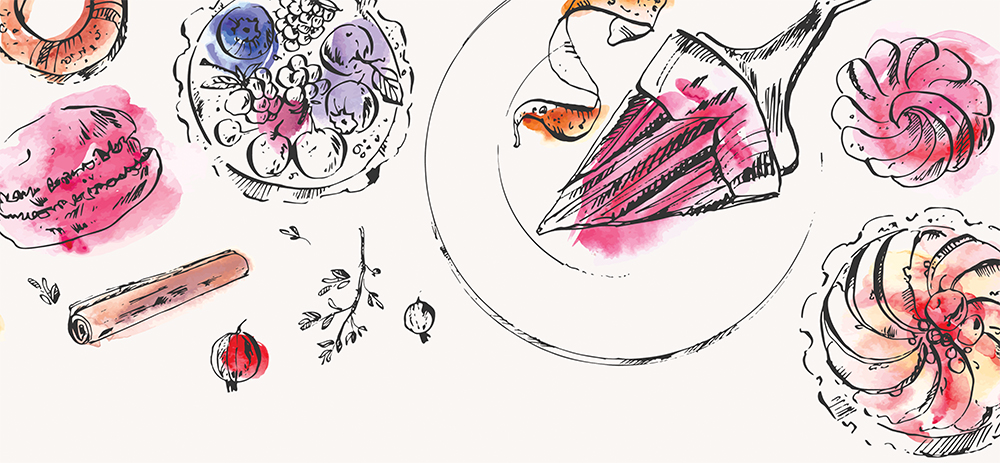With the help of local food writers, this month’s epicurean adventure takes us from Cambridge sticky bun wars to tracking a biscuit crumb trail through history to ancient Rome. Words by Dr Sue Bailey
You may ask why people want to know about food history, and why Cambridge is blessed with such an abundance of food writers with a lively interest in the subject. Dr Annie Grey, Tim Hayward, Bee Wilson and Lizzie Collingham are just some of those who lavishly spread a feast of words in books, articles and speech. Over this issue and the next, I’ll be finding out why this subject is so endlessly fascinating to readers and writers.
When I meet Tim Hayward, owner and revitaliser of Fitzbillies together with his wife Alison Wright, he is fizzing with energy. He is a food writer with four books under his belt, who shows a fascination for well-honed knives, DIY cookery and the neglected history of those weird kitchen objects: cherry stoner, anyone?
He is part way through a photo shoot and putting together recipes and key moments from Fitzbillies’ history for a book out early next year. This is to celebrate 100 years of Cambridge’s own “fancy cake shop”. It’s a six-week writing and photography sprint, but he took a break to sit outside Fitzbillies for a chat.
“We realised that we were one of the last surviving high street English fancy cake shops – at no point had it pretended to be a patisserie or a Viennoiserie,” he says. “We started digging into the history of cake shops and it’s something of an untold story. Pre-first world war, Austrian and German immigrants had set up sugar refineries, bakeries and cake shops. But when the war came, anti-German feelings meant many closed down.”
Tim continues: “When the war ended, men were coming back with demob money and bakery equipment manufacturers were really keen to finance these guys. So when the Mason brothers came back they found it very easy, as throughout the war their dad had been running a confectioner’s in Cambridge. So the two brothers set up the famous Fitzbillies with their demob money.”
Originally there were four branches of Fitzbillies, but we are lucky still to have two. Sadly, other cake and tea shop establishments such as the Whim have gone, but Fitzbillies upholds the tradition of macarons, the famous sticky Chelsea buns and lesser-seen treats such as Japonaise (which used to be known as Jap) cakes: a nutty meringue and buttercream sandwich.
I wanted to find historic Cambridge recipes
Tim even tells of cake wars in Cambridge. “There was a competition to see who had the stickiest buns. The waitresses used to put the buns in the window at a 45° angle and every 15 minutes the waitress would come out, scoop up the syrup and pour it back over the top. Now our trade secret is that we store our buns upside-down with half a kilo of syrup, then we pull them out and flip it over onto your plate. This stuff of the high street was real showmanship.”
Tim does his research and writing in a light and friendly manner and his books have achieved immense popularity. His book Knife: The Cult, Craft and Culture of the Cook’s Knife has even been translated into Japanese. He also regularly appears on BBC Radio 4’s The Kitchen Cabinet with Jay Rayner and local food historian, Dr Annie Grey. The cultural, historic and marketing parts of food and cooking equipment are Tim’s passion. But trying to prove the impossible history of jam or cream first on a scone is not what makes him enthusiastic.
Different writers have different approaches. Dr Lizzie Collingham is an academic with a love of chasing facts down, particularly little-known food history. She is an independent historian and has written three food history books, beginning with one on curry, then a look at food in the second world war and, more recently, an exploration of the food stories of the British Empire. She is now writing a book on the history of biscuits.
Her research goes back to the Greco-Roman times, with the origin of a twice-baked, thick barley rusk-style product of the historic name Paximadia, originating in Greece. “I was in Corfu and thought it would be impossible to find Paximadia, but then I went to a supermarket and I was delighted to find the whole wall covered with its namesake. The Roman name, ‘panis biscoctus’ in fact gives us the name biscuit.”
Currently, Lizzie is tracking the crumb trail through biscuit history. “I find it a bit difficult knowing when to stop – the trouble is, the history of contemporary biscuits gets a bit boring. I really don’t want to get into globalisation and palm oil. I am trying to decide if there’s a biscuit that sums up the 70s – Penguin or Club biscuits perhaps, nibbling the chocolate off the edges to enliven the packed lunch…”
Leaving Lizzie to her research in the university library, I reflect on when I started being fascinated by food history. I was 17 and I wanted to find out about historic Cambridge recipes. When we should have been drinking and partying, instead I dragged my fairly uncomplaining boyfriend to hunt recipe notebooks in the depths of the Castle Hill Cambridge county archives. We found an early Victorian recipe book by Emma Currie, written in 1826 in spiky, elegant handwriting. She was the housekeeper and cook for the Vinter family of Thriplow Manor.
Her recipe was my first encounter with the famous Trinity Burnt Cream, made with a pint of cream, eggs, lemon peel, orange flower water and a hot salamander. Next month I’ll be following up the history of this dish with Parker’s Tavern’s Tristan Welch, plus interviewing more Cambridge-based food writers. In the meantime, go hunt your salamander and try making Trinity Burnt Cream.

